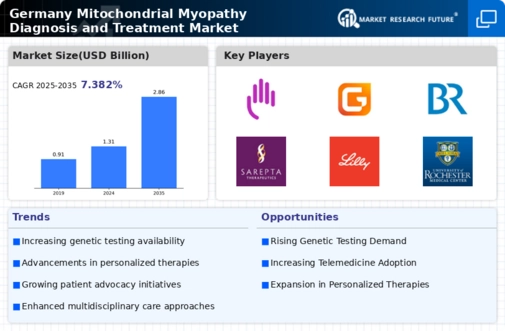Government Initiatives and Funding
Government initiatives and funding play a pivotal role in shaping the mitochondrial myopathy-diagnosis-treatment market. In Germany, various health policies and funding programs are being implemented to support research and development in rare diseases, including mitochondrial disorders. The German government has allocated substantial resources to enhance healthcare infrastructure, which includes funding for clinical trials and research projects focused on mitochondrial myopathy. This financial support is crucial for fostering innovation and ensuring that new diagnostic and therapeutic options are developed and made available to patients. Additionally, public awareness campaigns funded by the government aim to educate both healthcare professionals and the general public about mitochondrial disorders, further driving demand in the market.
Increased Focus on Personalized Medicine
The growing emphasis on personalized medicine is significantly influencing the mitochondrial myopathy-diagnosis-treatment market. In Germany, healthcare providers are increasingly recognizing the importance of tailoring treatments to individual patient profiles, particularly in the context of complex mitochondrial disorders. This shift towards personalized approaches is driven by advancements in genetic testing and a deeper understanding of the molecular mechanisms underlying mitochondrial diseases. As a result, there is a rising demand for targeted therapies that address the specific needs of patients. The market is witnessing the development of customized treatment plans that consider genetic variations, lifestyle factors, and disease progression. This focus on personalized medicine not only enhances treatment efficacy but also improves patient satisfaction, thereby propelling growth in the mitochondrial myopathy-diagnosis-treatment market.
Rising Prevalence of Mitochondrial Disorders
The increasing incidence of mitochondrial disorders in Germany is a crucial driver for the mitochondrial myopathy-diagnosis-treatment market. Recent studies indicate that mitochondrial myopathy affects approximately 1 in 5,000 individuals, leading to a growing patient population requiring diagnosis and treatment. This rise in prevalence necessitates enhanced diagnostic tools and therapeutic options, thereby stimulating market growth. As healthcare providers become more aware of these disorders, the demand for specialized diagnostic services and targeted treatments is likely to increase. Furthermore, the aging population in Germany, which is more susceptible to mitochondrial diseases, adds to the urgency for effective management strategies. Consequently, the rising prevalence of mitochondrial disorders is expected to significantly impact the mitochondrial myopathy-diagnosis-treatment market, driving innovation and investment in this sector.
Technological Innovations in Diagnostic Tools
Technological advancements in diagnostic tools are transforming the mitochondrial myopathy-diagnosis-treatment market. Innovations such as next-generation sequencing (NGS) and advanced imaging techniques are enhancing the accuracy and speed of diagnosis. In Germany, the adoption of these technologies is on the rise, with NGS becoming a standard practice in genetic testing for mitochondrial disorders. This shift is expected to improve patient outcomes by facilitating early diagnosis and personalized treatment plans. Moreover, the integration of artificial intelligence in diagnostic processes may further streamline operations, reducing costs and time associated with traditional methods. As these technologies become more accessible, they are likely to expand the market for mitochondrial myopathy diagnostics, ultimately benefiting patients and healthcare providers alike.
Collaboration Between Research Institutions and Industry
Collaboration between research institutions and the pharmaceutical industry is emerging as a significant driver in the mitochondrial myopathy-diagnosis-treatment market. In Germany, partnerships are being formed to accelerate the development of novel therapies and diagnostic methods. These collaborations often lead to the sharing of resources, expertise, and data, which can enhance the efficiency of research and development processes. For instance, joint ventures between universities and biotech companies are focusing on innovative treatment modalities, including gene therapy and enzyme replacement therapy. Such partnerships not only facilitate the translation of research findings into clinical applications but also attract investment, thereby bolstering the market. The synergy created through these collaborations is likely to yield breakthroughs that could transform the landscape of mitochondrial myopathy treatment.
























Leave a Comment